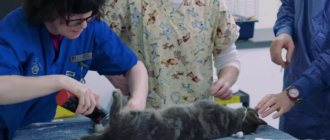Sterilization of animals is the only effective means of controlling their numbers. This problem has become especially relevant today, when in many countries the situation with the number of stray cats has become truly catastrophic. The most common method of ensuring sterility has always been surgical castration. But this technique, despite all its strengths, has many disadvantages. It requires anesthesia, sterile surgical equipment, and the operated pet needs more or less qualified care.
In addition, surgical castration is always fraught with certain risks (as, indeed, any other operation). Finally, many owners are negative about this procedure simply because they assume their pet will be in pain. Chemical castration of cats is designed to solve all these (or at least most of them) problems.
Pros and cons of the method
During medical castration, a hormonal drug is introduced into the animal's body to suppress sexual desire. As a result, the pet loses all functions associated with reproduction.
At the same time, chemical castration of cats and chemical sterilization of cats are very similar to each other.
There are several methods of the procedure:
- contraception using medications (injections or tablets);
- implant - special substances are injected under the skin;
- radiation exposure.
The advantages of the procedure are:
- Reversibility. The process can be stopped at any time. If the animal owner decides that he would like a kitten from his pet, it is enough to stop administering the drug. Owners of elderly cats often do this when they want to alleviate an upcoming loss.
- There are no risks of surgical intervention - infections, allergies to anesthesia drugs, difficulties with suture healing.
- Painless. Undoubtedly, the chemical method causes the cat less pain and suffering than the operating method.
Disadvantages of the procedure:
- The method is based on hormonal drugs, the effect of which on the body, as a rule, has not yet been fully studied. In addition, they have side effects and often lead to oncology, which can only be treated surgically.
- Duration in time. When choosing a chemical castration method, you need to understand that it will last the entire fertile period of the animal.
- Drugs for chemical castration often lead to excess weight gain and hair loss, in contrast to the classical method of castration.
- The cost of chemical castration will be higher than a one-time operation, since you will have to constantly buy medications.
To choose a specific type of procedure, it is necessary to analyze the advantages and disadvantages of each method. It is also worth understanding that the chemical method has not yet been sufficiently studied, and therefore there is no information about its possible consequences.
Chemical sterilization: what is it?
First, let's define the theory. You need to know that complete chemical sterilization (as opposed to castration) simply does not happen.
Thus, at present there are no substances (with the exception of hormones) that, when introduced into the general bloodstream of an animal, would be able to suppress its reproductive function.
Pros and cons of chemical sterilization
As we have already said, “chemical” infertility is not actually such due to the lack of specific drugs. Perhaps in the future such medications will appear, but today owners have to be content exclusively with hormonal drugs. This approach has both its pros (few) and cons (many more). However, first things first.
Let us list the positive nuances of this technique:
- There is no need for surgery. Perhaps this is the biggest (and, one might say, the only) plus of “chemistry”. But it is precisely for this reason that inexperienced breeders have high hopes for this technique.
- The cat can be released for a walk even five minutes after the “operation”. There is no harm to health. That is, “chemistry” is valuable because it lacks anesthesia and, accordingly, its consequences.
- Another point that can be considered a plus. So, “chemistry” is a temporary measure. When the hormones wear off and the animal's reproductive system starts working again, the cat can become pregnant again. True, there is no guarantee that the kittens will be born healthy after this, and the pregnancy itself will pass without complications.
We can say that this is where all the positive aspects end.
This method has significantly more disadvantages:
- Hormones are substances that, despite all the achievements of modern science, have not yet been fully studied. More precisely, the long-term consequences of their long-term use are not really known. But almost all veterinarians and biologists agree that nothing good should be expected.
- It is known that cats whose estrus was stopped for more than two or three years using various versions of the “Sex Barrier” very often subsequently developed cancer of the reproductive system. The same applies to the consequences of “chemical” sterilization: cancer after it is not uncommon.
- You should not hope that immediately after the procedure the cat will lose sexual instincts, stop running around looking for cats and screaming unpleasantly. Indeed, all this will end, but not immediately: about a month will pass until the cat finally forgets about the “adventures”. However, the pronounced effect of some drugs begins... about six months after administration (more on this below).
Until the drug has taken effect, any mating will lead to pregnancy. Those. A “sterilized” cat will have to be constantly monitored.
Comparing all the pros and cons, you will notice that there are more cons. And further. If the owner decides on chemical sterilization, we would recommend taking into account three important recommendations:
- It is better to subject old cats to chemical degeneration. The hormonal levels of their body are already reduced due to age-related reasons, but such animals can still become pregnant. Carrying kittens at this age is a heavy blow to the body, and therefore “happy motherhood” is best avoided.
- Before the age of three, it is better to forget about “chemistry”. The long-term consequences are sure to show up afterwards, and they are guaranteed to be severe. If the owner wants to sterilize his pet, then at this age the ideal option is a laparoscopic type of desterilization. Surgical intervention is minimal, and the animal recovers from its consequences very quickly.
- It is necessary to resort to “chemistry” after the heat, or long before it. Trying to extinguish sexual heat that has already begun with lethal doses of hormones is a bad idea; the cat’s body will subsequently feel very bad.
Contraception with drugs
Medical castration implies:
- Taking tablets or drops.
- Animal injections.
The pills used are “Sex Barrier”, “Contra-Sex”, “Cat Bayun”, “Sex Control” and others. This is the most economical method of contraception. And it comes to the rescue in situations where the pet’s sexual desire needs to be suspended only for a while. But the constant use of hormonal drugs leads to the development of cancerous tumors, and those cats who have been diagnosed with liver problems should not use them at all. It is not for nothing that such drugs (“Sex Barrier” and others) are prohibited in many countries, and some even provide for criminal prosecution for their use to reduce the reproductive function of pets. Unfortunately, in our country, the packaging of these products does not contain reliable information about the side effects of the substances included in their composition.
Contraception with medications
With this method of contraception, there are 2 methods. Among them, injections or tablets (drops) should be highlighted.
- Among drops and tablets, the most popular are medications from well-known companies under the names “Conra-sex”, “Sex-barrier” and “Cat-bayun”. This method is considered the cheapest method of sterilization.
- Only here it is worth noting some disadvantages. Often, with the regular use of such drugs, oncological pathologies develop in animals. In cats, tumors of the ovaries, appendages and mammary glands form.
- As for chemical castration of animals, the procedure is carried out in the form of injections. Veterinarians often use a drug called Covivan. The effect of the drug lasts up to six months. This substance is only allowed for use on cats.
- Not many owners of four-legged friends know that in European countries it is prohibited to give hormonal drugs to pets. Some states even provide criminal penalties for such actions.
- The main problem with using the drugs is that the receptors are located throughout the body, and they take in all the progesterone. Because of this, a cancerous tumor can develop in any organ whose functioning is regulated by hormones.
- Numerous studies have shown that substances that suppress estrus and testicular activity contribute to the development of diabetes in animals. In addition, the activity of the endocrine system significantly deteriorates.
- Keep in mind that side effects from the drugs used are very difficult to predict. Ultimately, the resulting pathologies will have to be treated for the entire lifespan of the animal. Keep in mind that the worst consequence of such drugs is considered to be pyometra.
- The disease is accompanied by thickening of the uterine mucosa. In such an environment, cysts and small bubbles begin to form. After this, pus appears. The disease can be detected in acute form. The uterus will be filled to capacity with pus. At the same time, it becomes painful and red.
- An animal with this disease will not eat and can barely move. Thus, intoxication of the entire body occurs. Appetite disappears, and thirst increases significantly. The animal will constantly drink water. A specialist can save your pet if he cuts out the uterus.
When sterilizing an animal, study all the positive and negative aspects of the presented methods. Don't skimp on this procedure. You should not give your animal medications. In this case there will be many side effects. The pet will often get sick and suffer constantly. Take the procedure seriously and consult your veterinarian.
how to care for a cat after sterilization
Side effects
The medicine used as an injection is Covinan, but it is used for cats. According to scientific research, a tumor in response to the administration of such drugs can form in any organ of the animal whose activity is regulated by hormones. As for medications for cats, they can cause the development of diabetes mellitus and impair the functioning of the endocrine system. It is impossible to predict how this or that medicine will affect you, but you will have to be treated for pathologies for the rest of your life.
So, it should be recognized that the simplicity of the method of chemical castration of cats is offset by serious side effects, the onset of which is often difficult to foresee.
Indications for chemical castration of male dogs
The indications for chemical castration are exactly the same as for traditional castration. This is the prevention of uncontrolled reproduction of dogs and the suppression of sexual desire - and related problems.
If the owner does not plan offspring from this dog (never and under any circumstances), then surgery is preferable. If the problem is different, it makes sense to consider the introduction of “Suprelorin” as an alternative.
Behavioral problems
Castration of male dogs is often recommended as a remedy for aggression. But if a dog growls at children, bites owners, or lunges at relatives during a walk, this is not always associated with the reproductive instinct. Most often this is a task for the dog handler, and castration will not solve the problem. You can check this with the help of Suprelorin. If, after installing the chip, aggression decreases or disappears, the operation makes sense.
The same goes for indoor tagging. Castration most often helps to get rid of annoying peeing in the apartment. But as the owners of some stubborn dogs rightly note, sometimes a male dog neutered in adulthood continues to wet the corner of the sofa, either out of spite or out of habit. If it is difficult for owners to decide on a traditional operation, they resort to chemical castration.
I was told that we were going to the clinic for castration, but it seems my “guys” are still there!
Alopecia X
Baldness in a dog, the cause of which is not clear, is called the beautiful term “alopecia X”. This problem occurs in certain dog breeds, such as Spitz, Chow Chow, and Malamute. The guard hairs fall out and a soft undercoat remains. And then the skin becomes smooth. No anxiety or itching is observed.
One of the reasons for such baldness is problems with sex hormones. The first thing a dermatologist recommends is castration. This really helps most dogs and their fur returns as if by magic. Therefore, alopecia X in some sources is called alopecia “treatable by sterilization.”
It is difficult for owners to understand how the testes and hair loss in their dog are related. It’s difficult to decide on such an operation - what if we cut it off in vain? Such a patient should have a Suprelorin chip installed. If the dog begins to grow overgrown, he will later be surgically castrated. If not, look for another cause of alopecia.
Pomeranian Spitz, diagnosed with alopecia X, castration recommended
Prostate hyperplasia
Prostatitis is more common in older male dogs. It happens that it is too risky to operate on such a patient due to heart or kidney problems or concomitant diseases such as diabetes. Then prostate hyperplasia is treated with medication, after which the dog is prescribed Suprelorin for life.
Stimulation of sexual activity
It is a paradox to administer a castration drug to stimulate the stud dog. But the implant acts in such a way that in the first two weeks after insertion, the concentration of sex hormones, on the contrary, goes through the roof. Breeders use Suprelorin when they need to increase the activity of a dog and carry out a series of matings. Then the chip is left or removed - at the request of the owners.
"Test" castration
Veterinarians never tire of repeating that castration does not harm the dog’s working qualities. But the owner has the right to make sure of this before taking the dog for surgery. Suprelorin is given to herding, hunting, guard and working dogs to see if decreased libido will prevent them from performing work as well as before.
Shared keeping of dogs in kennels
Suprelorin is often used by professional breeders. Let's say there are two breeding dogs and four bitches in a house. And the breeder wants to use only one of them for mating. What should the other one do when the ladies go into heat? Just climb the wall, pee on everything around and refuse to eat. If you use Suprelorin, both the dog and the owners can live in peace. And after the end of the implant, this male can be used for mating in the kennel or outside.
We recommend reading: Cat bed
Guess. Which of them is under the influence of Suprelorin?
Or there is a stud dog of one breed and a bitch of another at home. Surgical castration is not advisable because you want to use him for breeding. In this case, you can use Suprelorin while the bitch is fertile and stop inserting implants after she is spayed.
For those who think that “they won’t succeed anyway,” I suggest you admire the Dachshund and Labrador mix HERE (link will open in a new tab).
Indian experiment
In 2011, Indian veterinarians made an amazing discovery. While solving the problem of limiting the number of stray animals, they discovered a “miracle” remedy that has a contraceptive effect. It turned out to be calcium chloride, previously actively used in medicine and veterinary medicine for other purposes.
This substance began to be injected into the testes of animals. The ideal dosage was 0.25 calcium chloride at a concentration of 10%. Five minutes after the administration of the substance, the animals showed minor signs of discomfort; in some, the testes swelled. But after a while all the unwanted reactions stopped.
As a result, sperm production in animals decreased, thus reducing the number of stray cats. However, the method requires further study.
Implant method
The most gentle way to chemically castrate cats is to implant a chip under the skin of the animal at the withers. The chip itself is a small cylinder, about the size of a grain of rice, and the medicine dissolves over time.
The drug in the implant begins to work after about six months, and its effect lasts up to one and a half years. This is the main drawback of the product. Mating a cat within a six-month period after administration of the drug will lead to the appearance of offspring.
Non-invasive castration methods
In addition to surgery, there are 3 methods of castration.
Radiation exposure
The essence of the method: dosed exposure to a radiation agent on the testes, which leads to a sharp decrease in sexual activity, up to its complete absence.
Advantages: simplicity, high efficiency.
Disadvantages: high risk of developing cancer.
Medical castration
The essence of the method: special hormonal drugs are administered orally or parenterally, suppressing sexual desire.
Advantages: reversibility, no preparatory period.
Disadvantages: risk of side effects, need to observe the administration time every day, questionable effectiveness.
Subcutaneous implants
The essence of the method: implantation of a capsule with a long-acting hormonal drug under the skin.
"Suprelorin" - a drug for non-surgical castration
Currently, the drug “Suprelorin” is used for medical castration of cats. It is injected under the skin of the animal in the form of an implant. The active ingredient is deslorelin. The drug is produced by the French company Virbac. “Suprelorin” for cats is supplied to Russia in a dosage of 4.7 mg.
Deslorelin in the implant is combined with a fat base, thereby achieving the effect of slow release of the active substance. Thus, deslorelin is gradually absorbed into the blood. The effect of the drug is that under its influence the production of sex hormones stops, both male in cats and female in cats.
Experts, noting the benefits of deslorelin, say that it has no side effects, unlike other substances with similar effects.
About chemical castration of dogs and cats
Spring will soon come - the time of awakening not only of all nature - grass, flowers, buds on trees, but also of activating the instinct of procreation of our pets. In fact, spring is not always to blame. But probably every owner asked himself the question of castration of his animal.
It is customary to carry out this surgical operation on domestic animals that are not of interest for breeding, as well as when indications for it are pathologies of the reproductive organs (tumors, pyometra, prostatitis, prostatic hyperplasia, false pregnancies, etc.). However, the problem of intense sexual behavior in pets bothering owners is one of the most common reasons for castration. This behavior includes increased libido, escapes in females and males, scent marks, fear, aggressive and dominant behavior between animals, males mounting other animals, objects/toys or human feet. Among animal owners there is not, and is unlikely to be, a consensus on the need to castrate dogs and cats that live at home and do not plan to breed, but this article is not about that. Let's talk about chemical castration in animals. It’s hard to believe, but it is used even in breeding animals when necessary, and not just in those whose owners have not yet decided whether the animal needs to be castrated through surgery or not. In addition to their intended purpose, chemical castration chips are also used for other purposes.
In the reproductive sciences of small domestic animals, the so-called chemical castration. What is it and what is it for?
Chemical castration refers to the use of subcutaneous chips with the active ingredient deslorelin. In our country, a chip with deslorelin (suprelorin) is licensed exclusively as a drug for medical castration of males, but there are many scientific studies proving the effectiveness of this drug not only in males, but also in females, as well as in cats, and it can be used both for the effect of castration, and vice versa - to stimulate estrus. This chip is small in size, slightly larger than a grain of rice, white in color, slowly dissolving in the subcutaneous tissue of the animal, thereby its active substance enters the body in uniform doses and exerts its effect. As this implant dissolves, the castration effect lasts. Accordingly, the effect of castration is reversible; as soon as the chip is completely absorbed, the reproductive function fully returns. The onset of the castration effect itself does not occur immediately, but 2-3 weeks after implantation of the chip. Until this time, the opposite stage of gonadal hyperstimulation occurs in male and female dogs and cats, that is, first a kind of “hormonal explosion” occurs with all the ensuing characteristics - sexual behavior intensifies, the onset of estrus is provoked in females and cats, and then this period subsides and “hormonal calm” lasts for quite a long time. In dogs from 0.5 to 1.5 years, in cats from 0.5 to 3 years. It's all about the regulation of hormones in the body.
Normally, the hypothalamus secretes gonadotropin-releasing hormone (GnRH), which influences the pituitary gland to produce follicle-stimulating and luteinizing hormones, which in turn stimulate the gonads to produce sex hormones. When there are already enough sex hormones, a feedback signal is sent to the brain and the hypothalamus reduces the production of the GnHR hormone. When placing a chip with deslorelin, and it is a GnRH agonist, that is, an analogue. With its constant intake of GnRH into the body, its receptors in the pituitary gland become hypersensitized and 2-3 weeks after implantation of the chip stop responding to its stimulation.
In the vast majority of cases, active sexual behavior disappears, and the effect of chemical castration is almost completely identical to surgical castration. The number of cages decreases by 50-70% (they can remain even after surgical castration as a habitual behavior, since cages are not always the result of increased libido, but a psychological problem of behavior), sperm production and, accordingly, the volume of the testes decreases, aggressive behavior between same-sex animals also becomes less . If aggression is directed at a person, then for the most part it is less hormonally dependent, so any castration, chemical or surgical, will not be a solution to the problem. Chemical castration can be an excellent alternative for those animals that are contraindicated for anesthesia, such as cats (and cats) with hypertrophic cardiomyopathy (HCM). *The use of chemical castration is not recommended and even contraindicated for the treatment of prostatitis.
How else can you use castration chips?
Stimulation of estrus and pregnancy
. Cats and bitches will definitely go into heat after implantation of the chip. Induction of estrus occurs due to the effect of a hormonal explosion, and it is required for the treatment of certain problems of reproductive dysfunction - in the treatment of primary and secondary anestrus, as well as for synchronizing estrus. Ovulation occurs approximately 10-12 days after the chip is placed, but for a full mating you need to monitor your progesterone level. Also, during pregnancy in these animals (if the chip was placed specifically to stimulate estrus and pregnancy), it is necessary to control the level of progesterone, which may decrease, which without additional drug support will lead to abortion of the fetuses. If the chip is placed to stimulate estrus, then it is inserted into the navel area, so that it can then be easily found and removed under local anesthesia and no earlier than 7 months after the last estrus, otherwise the estrus may not come. And it is very important to conduct an ultrasound scan of the uterus and ovaries before placing an implant, since if there are pathological changes in them (ovarian cysts, cystic endometrial hyperplasia, etc.), the progression of these pathologies due to primary hyperstimulation or the effect of the chip may not be for whatever purpose it was not used.
Treatment of X-alopecia.
With chemical castration, the coat is restored in approximately 50-60% of cases, but when the chip stops working, x-alopecia in dogs manifests itself again. If there was such a positive moment when placing the chip, then this fact helps people decide to undergo surgical castration.
Treatment of benign prostatic hyperplasia
by placing a chip is permissible, but one must take into account the temporary worsening of the disease in the first 2-3 weeks after implantation of the chip. Thus, the volume of the prostate decreases by 60% in about the first month.
Treatment of Reminent Ovarian Syndrome
, if a repeated operation to find and remove it is impossible for some reason.
According to new data, chip implantation has a positive effect on urinary incontinence in neutered female dogs!
The mechanism of action for these indications has not yet been fully described.
Once the chip wears off, reproductive function in dogs and cats is fully restored. Normal testosterone levels are observed 18 months after implantation in 98% of dogs. In cats, fertility is restored 5-15 weeks after testosterone levels are restored.
To summarize, we can conclude that chemical castration has a place in animal reproduction for various purposes - both for castration and for the opposite purpose - pregnancy, and is reliable and safe. In dogs and cats, it has its own characteristics in terms of duration of action.
If your pet needs chemical castration, a reproductive specialist at the Vetstate veterinary clinic will perform this procedure 7 days a week, 365 days a year.
Without holidays or weekends, we are happy to see you 24/7. Appointments can be made by calling
8
8
Features of the use of "Suprelorin"
Since the drug was originally produced for the sterilization of dogs, its use for chemical castration of cats has its own characteristics. The active substance exhibits its activity 14-30 days after administration. The amount of testosterone in the animal decreases, sexual function is completely inhibited. The cat stops marking territory, showing aggression, and making inviting sounds. But it is impossible to give the exact duration of the implant. Usually this is a period from 6 to 37 months. After removal of the implant, sexual function is restored within 3 months.
Side effects include swelling at the site where the chip was implanted, as well as shrinkage of the testes. The testicles may also become swollen.
Veterinarians advise using this method of castration on adult animals. No studies have been conducted on the effects of drugs on young individuals. Each animal owner decides which castration method to choose independently. It is important to weigh the pros and cons of each method before making a decision.
Surgical methods of cat castration
Any of the surgical methods of castration has its own nuances, ranging from the surgical technique to the effect on the process of regeneration of damaged tissues and the post-castration existence of the animal. All surgical procedures are performed under general anesthesia (routes of anesthesia: inhalation, intravenous or intramuscular).
We invite you to read: Top 10 most poisonous snakes in the world
Bloody
- closed method. The scrotum is dissected to the vaginal membrane (the skin, the muscular-elastic layer, and fascia are cut), it is dissected without opening it to the inguinal ring, and then it is compressed together with the spermatic cord or tied with a ligature. The spermatic cord and tunica vaginalis are cut below the ligature;
- open method (“classical castration”). The scrotum and vaginal membrane are cut, the transitional ligaments are crossed with scissors, the testes and appendages are cut off by ligating, unscrewing or tearing off the cord.
Percutaneous (bloodless)
The main goal is to block the innervation and blood supply to the testes. The spermatic cords are crushed over their entire diameter with special forceps; within 4-5 months they atrophy and dissolve.
Pros of the radical approach: affordable price of the operation, short postoperative period, the cat’s sexual functions are not restored. Cons: likelihood of complications after anesthesia/surgical intervention.
Vasectomy (sterilization)
A simple and effective operation in which segmental bilateral ligation of the vas deferens is performed, as a result of which the cat becomes sterile.
Pros: preservation of the testes, low trauma (manipulations are performed under local anesthesia). Cons:
- high price;
- careful postoperative care of the animal is required for 10-12 days;
- not every veterinarian will undertake to perform the operation due to its complexity;
- vasectomy does not affect the production and distribution of testosterone (the animal retains normal sexual responses and the ability to mate).
Cats are sterilized, as a rule, in one of three main ways, differing, in fact, only in access to the abdominal cavity: access along the white line of the abdomen (the most common method) access through a side incision one or more punctures of the abdominal wall in order to remove the reproductive organs using laparoscopic equipment.
1. Sterilization of cats with surgical access along the white line of the abdomen is the most common and familiar method. The animal's fur is shaved from the navel to the last pair of nipples, a skin incision is made, then the aponeurosis of the abdominal wall is cut (in the center, between the muscles, without bleeding).
Photo 2. Skin incision during sterilization of a cat with access along the white line of the abdomen
After this, the surgeon removes the uterine horns and, depending on the sterilization method, ligates the vessels and removes only the ovaries or the ovaries and the uterus.
Photo 3. Castration of a cat. Extraction from the abdominal cavity and removal of the uterus and ovaries
Sutures are then placed on the abdominal wall and skin.
Photo 4. The abdominal wall is sutured with a continuous suture using absorbable thread.
The peritoneum is sutured with absorbable suture material, the skin suture is performed in various ways, depending on the specific animal, the wishes of the owner, conditions of detention, etc. A little later we will dwell in more detail on the sutures placed on cats during sterilization.
To prevent the cat from licking the seam and introducing dirt and infection, a postoperative blanket is worn. The blanket is removed on the day the stitches are removed, not earlier.
The length of the incision for ovario- and ovariohysterectomy with access along the white line of the abdomen is from 1.5 to 5 cm, depending on the size of the animal, the presence of pathologies and the qualifications of the surgeon.
2. Surgical access through a lateral incision has been developed and is used mainly in the implementation of a program for sterilization of stray animals, without overexposure. Cats that wake up after anesthesia are immediately released into the external environment. Therefore, the method provides for low tissue trauma, a relatively small incision and no need for suture care. Ovariectomy is most often performed this way.
Photo 5. Removal of the uterus during sterilization of a cat through a lateral tissue incision
The good thing about this method is that the length of the suture is much shorter than with traditional ovariohysterectomy. A cat recovers quickly after such an operation and requires less care than after an operation with an incision along the white line.
In this case, tissue trauma is more pronounced due to damage to the muscle layer. When sterilizing along the white line, it is not the muscles that are damaged, but the aponeurosis (connective tissue).
Veterinarians do not like the lateral approach due to the inability to objectively assess the condition of the animal’s organs and take appropriate measures or give recommendations to the owner for further diagnosis or treatment of the animal (for example, an enlarged spleen or coprostasis in the intestines). In addition, muscle repair can be even more painful than aponeurosis repair.
3. Modern, low-traumatic and safe method -. Allows you to combine the possibility of complete visualization of the abdominal organs and ultra-low tissue damage.
We suggest you familiarize yourself with: Scottish Straight Longhair cat
Photo 6. Laparoscopic sterilization of cats ensures the highest degree of sterility
Laparoscopic sterilization of cats is carried out with a special instrument - a laparoscope, which is a tube with a video camera unit and a lens. The resulting image is displayed on the monitor and allows the doctor to carry out the procedure under full visual control.
Photo 7. Puncture of the abdominal wall with a trocar during laparoscopic sterilization of cats
The operation is performed through small incisions (up to a centimeter in length), into which a manipulator and laparoscope are inserted.
Photo 8. 3 mm punctures left after laparoscopic sterilization of a cat do not need to be sutured. They are simply sealed with medical glue.
To create an operative space, a carboxyperitoneum is created - the abdominal cavity is filled with carbon dioxide, the abdominal wall rises, and the internal organs are in excellent visual access for the surgeon. All manipulations are performed directly in the abdominal cavity, bleeding is stopped by coagulating blood vessels and tissues, and the removed organs are removed through a puncture in the abdominal wall. Both spaying and neutering of cats can be performed laparoscopically.
Advantages of the laparoscopic method of sterilization of cats:
- Minimal tissue trauma
- The highest degree of sterility during surgery (contact of the surgeon’s organs and hands is completely excluded, only sterile instruments)
- Good visualization. The opportunity for the surgeon to conduct an inspection of internal organs, both during and after surgery, to assess postoperative risks. Modern laparoscope video cameras provide excellent magnification. Even hamsters, mice and chinchillas can be operated on comfortably and with high quality.
- No need for postoperative treatment. Seam processing is minimal. If the puncture is made with a 0.3 or 0.5 cm trocar, no stitches are applied at all, the wound is simply sealed.
The main disadvantage due to which laparoscopy is available in a very limited number of veterinary clinics is the high cost of equipment and the need for additional training of employees.
The cost of laparoscopic sterilization of cats is always higher than the cost of traditional methods of sterilization.
For any of these three methods, general anesthesia is required.











